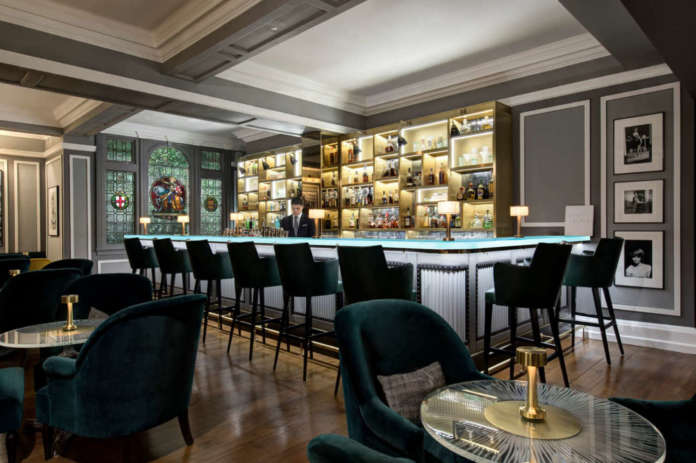
I bar degli hotel hanno avuto una grande influenza sul modo di bere e di socializzare, soprattutto per l’élite. Oggi, fortunatamente, il bar d’hotel si è evoluto in un ambiente più inclusivo, che si rivolge a un segmento più ampio della popolazione. Ma per capire come sia diventato un luogo d’incontro elegante e divertente per tutti, è importante riavvolgere il nastro e ripercorrerne la storia.
Come è noto il bar d’hotel ha registrato un vero boom sia negli Stati Uniti sia in Europa in un’epoca conosciuta come la Golden Age, che va dal 1860 all’inizio del Proibizionismo negli Stati Uniti, un periodo che ha visto l’invenzione di molti cocktail classici che si bevono ancora oggi. A distanza di parecchi decenni, intorno al 2000, è iniziata una seconda Golden Age grazie all’apertura di cocktail bar come il Milk and Honey di Sasha Petraske a New York. Questi format della New York dei primi anni 2000 hanno dato il via a una nuova ondata di cocktail bar in tutto il mondo rilanciando anche i grandi bar d’albergo.
Il primo importante bar d’hotel di quest’epoca è il Connaught Bar di Londra, gestito dal pluripremiato Agostino Perrone, che ha aperto le sue porte per la prima volta nel 2008. Con l’ospitalità italiana che lo contraddistingue, il Connaught Bar raggiunge un perfetto equilibrio tra il vecchio e il nuovo con il suo elegante Martini Trolley, servizio al carrello del cocktail Martini con bitters prodotti artigianalmente. Per Perrone, Director of Mixology, il segreto del successo del Connaught è l’attenzione per gli ospiti: «Sin dall’apertura abbiamo progettato un’offerta di drink e un tipo di servizio capaci di coinvolgere l’ospite e di renderlo protagonista del nostro bar. Tutti possono trovare la propria dimensione al bar, con una lista di cocktail che soddisfa gusti molto diversi. Ogni creazione è stata pensata per creare un legame con i nostri ospiti, per permettere loro di relazionarsi con le nostre idee e il nostro processo creativo. Questo concetto può spaziare dalla spiegazione e personalizzazione di un cocktail, come il nostro Connaught Martini con il servizio al carrello, alla progettazione di un mixer speciale o di molle per il ghiaccio che permettono all’ospite di aggiungere il tocco finale al drink sul tavolo, o anche elementi customizzati come i biglietti che accompagnano i drink speciali. Qualunque cosa facciamo, ci assicuriamo che i nostri ospiti si sentano speciali, indipendentemente dalla loro provenienza e dal motivo per cui sono venuti».
Dal 2012 al 2016, il dinamico duo composto da Alex Kratena e Simone Caporale ha infiammato il mondo dei cocktail durante il periodo trascorso all’Artesian dell’hotel Langham di Londra. Con l’obiettivo di non creare “un altro noioso bar d’hotel”, Kratena e Caporale hanno servito signature cocktail con presentazioni controcorrente, come la loro famosa Piña Colada versata da una macchina per granite. Grazie al loro nuovo stile di drink, unito a uno spiccato senso per l’accoglienza, l’Artesian è diventato un beniamino sia dei consumatori abituali sia dagli addetti ai lavori. Lo dimostra il fatto che l’Artesian ha vinto il premio The World’s 50 Best Bars per ben quattro anni consecutivi durante la gestione di Kratena e Caporale.
Nel 2014, Ryan Chetiyawardana è andato controcorrente rispetto ai classici bar d’hotel con l’apertura del Dandelyan all’hotel Sea Containers di Londra. Dandeylan, ora chiamato Lyaness, ha ispirato gli ospiti con il suo menu di cocktail botanici. Più che il menu, era l’atmosfera a essere completamente nuova. L’obiettivo di Chetiyawardana per il Dandelyan era creare un “bar di quartiere in un ambiente a cinque stelle”. Così il suo team ha trasformato lo spazio lussuoso e opulento del Sea Containers in un ambiente più accogliente, comodo e semplice. Con un dj che diffonde ritmi hip hop, il Dandelyan/Lyaness offre un’esperienza di bar divertente e disinvolta in un hotel di lusso.
Nonostante la sua età, il Donovan Bar è un altro punto di riferimento per i moderni bar degli hotel. Il Donovan Bar si trova all’interno del Brown’s Hotel, aperto per la prima volta nel 1837, il che lo rende uno degli hotel più antichi di Londra. Nel 2018 è stato rilanciato dopo una riprogettazione e l’arrivo del celebre barman e consulente Salvatore Calabrese. “The Maestro” ha creato un’atmosfera di classe ma informale, dove tutti si sentono benvenuti. Per far sentire i suoi ospiti a casa, indipendentemente dal loro stipendio, punta su diversi aspetti. «Tutto inizia all’ingresso. Al Donovan Bar abbiamo un ingresso separato che permette agli ospiti di accedere liberamente all’area del bar. Anche se siamo orgogliosi di far parte del Brown’s Hotel, questo dà al Donovan un’identità separata e mette l’ospite più a suo agio, potendo scegliere di non passare attraverso l’area della reception dell’hotel. È capitato a tutti di arrivare all’ingresso del bar di un hotel e sentirsi chiedere se siamo ospiti dell’albergo o se abbiamo prenotato. Al Donovan non abbiamo una hostess e spetta al nostro bar manager e al team di sala far sentire gli ospiti immediatamente come se fossero a casa loro. In questo modo, non c’è più il timore di essere respinti all’ingresso. Gli ospiti si sentono più tranquilli venendo al Donovan, e anche se non hanno prenotato, facciamo del nostro meglio per accogliere tutti, anche nelle serate più affollate».
Da Londra la cultura del bar d’hotel si è diffusa in tutto il mondo nell’era moderna, in particolare a Singapore, che quest’anno ospiterà tre grandi eventi dedicati ai cocktail: gli spin-off di Bar Convent Berlin e Tales of the Cocktail e il gala dei World’s 50 Best Bars. Sebbene Singapore abbia dato un importante contributo alla cultura del cocktail durante la prima Golden Age (pensate al Singapore Sling creato al Raffles Hotel), è solo dagli anni 2000 che la città-Stato si è imposta veramente sulla scena. Grazie all’inaugurazione nell’ottobre 2011 di uno street bar in stile newyorkese, chiamato 28 HongKong Street, Singapore è entrata a far parte della mappa mondiale dei bar. Sulla scia del successo del locale, i co-fondatori Paul Gabie e Spencer Forhart hanno lanciato un’impresa di distribuzione di alcolici, di consulenza per bar e formazione nel settore dell’ospitalità chiamata Proof and Company.
Il primo progetto di Proof and Company è stata l’ideazione di un moderno bar d’hotel per il Regent Four Seasons di Singapore. Dato l’amore dei fondatori per la cultura newyorkese dei cocktail, hanno chiamato il bar Manhattan, inaugurato nell’aprile 2014. Anche se attualmente l’hotel, ora Conrad Singapore Orchard, sta rinnovando le sue stanze, il Manhattan Bar, gestito da Rusty Cerven, continua a riscuotere successo, a riprova del fatto che nel corso degli anni si è costruito una clientela fedele e diversificata. Il bar si distingue per il fatto che non si trova nella hall dell’hotel, ma in uno spazio chiuso al secondo piano, il che lo fa percepire come un bar indipendente. Con la prima rickhouse al mondo con cocktail invecchiati con il metodo Solera, un vivace brunch domenicale con Champagne, cocktail classici e signature ben bilanciati, è il punto di riferimento per tutti gli appassionati di cocktail, sia di Singapore sia fuori città. Come spiega l’ex head bartender Gabriel Carlos, ora bar manager del vicino e fiorente Four Seasons One-Ninety Bar: «I bar d’hotel erano considerati una comodità. Ora sono una destinazione».
Il Manhattan Bar ha dato il via a un boom di bar d’hotel a Singapore, tra cui One-Ninety Bar (Four Seasons), Origin (Shangri-La), MO Bar (Mandarin Oriental), Writers Bar (Raffles) e Republic (Ritz Carlton), ma anche in tutto il Sud-Est asiatico. Konstantin Nemolochnyi, beverage manager del Republic, situato all’interno del Ritz Carlton, Millenia, ha spiegato il motivo per cui i bar degli hotel di Singapore attraggono una clientela così ampia: «Innanzitutto, Singapore ha beneficiato di una cultura del bere relativamente nuova, con ospiti locali più aperti al cambiamento. In secondo luogo, i bar d’hotel di Singapore fanno un ottimo lavoro di marketing per i bar con una propria identità, menzionando raramente l’hotel nel nome del bar. Basti pensare a Republic, Manhattan e Origin: sono i bar che diventano le vere è proprie destinazioni degli ospiti e non gli hotel dove si trovano».
Di più. Per attirare i clienti, i moderni bar d’hotel si affidano anche all’antico motto immobiliare “location, location, location”: collocando gli hotel e i rispettivi bar vicino ad attrazioni, siano esse naturali o costruite, si può attingere a un bacino di clientela molto più ampio. Così, negli ultimi anni Edmonton, nella provincia canadese dell’Alberta, ha visto un boom della scena dei cocktail bar grazie allo sviluppo dell’ICE District, un distretto dell’entertainment da 1,7 miliardi di euro realizzato in centro. L’attrazione principale è il Rogers Place, sede della squadra di hockey su ghiaccio Edmonton Oilers. Poiché l’hockey è lo sport più seguito in Canada, l’hotel JW Marriott ha puntato sul sicuro aprendo proprio accanto all’arena di hockey. Il JW Marriott Edmonton Ice District & Residences è in realtà un grattacielo a uso misto, con l’hotel situato dal 1° al 22° piano, mentre i condomini di fascia alta occupano i piani dal 23° al 54°. In questo modo, i punti vendita di food and beverage del JW Marriott possono contare sul traffico degli ospiti dell’hotel e dei condomini, ma anche dei numerosi fan dell’hockey che visitano l’ICE District. L’hotel a 5 stelle JW Marriott dispone di due cocktail bar, un lobby bar informale che consente agli ospiti di seguire le partite di hockey su un grande schermo televisivo, o il più esclusivo e nascosto bar Alchemy, un cocktail e lounge bar intimo che serve drink artigianali più sofisticati. Situato al quinto piano dell’hotel, Alchemy è dotato di un ampio patio riscaldato che si affaccia sul vivace ICE District del centro di Edmonton.
Certo è che i moderni bar d’hotel continuano a prosperare grazie alle loro identità sempre più indipendenti e alle atmosfere meno formali e più inclusive, senza compromettere la classe. Paul Gabie, co-fondatore di Proof & Company e numero 36 della Bar World 100, una lista delle figure più influenti dell’industria del bar, condivide le sue idee sul futuro dell’bar d’hotel: «I bar d’hotel hanno svolto un ruolo fondamentale fin dal 1800 e tornano in auge con la rinascita del grande bar d’hotel negli ultimi 15 anni. Molti dei miei bar preferiti al mondo oggi si trovano negli hotel e non ho dubbi che il bar d’hotel continuerà a svolgere un ruolo da protagonista del bere bene negli anni a venire. Il meraviglioso talento e la creatività che vediamo oggi negli hotel di tutto il mondo sono uno dei grandi tesori della nostra industry». *
Leggi l'approfondimento sul numero di aprile di Bargiornale
ENGLISH VERSION
The Evolution for the Hotel Bar

JW Marriott Edmonton Lobby Bar (Photo Pauline Yu)
Hotel bars have had a great influence on the way we drink and socialize, particularly for the elite. Thankfully these days, the hotel bar has evolved into a more inclusive setting, that appeals to a wider segment of the population. But to understand how the modern hotel bar has become an elegant yet fun meeting place for all, it is important to see where it all started.
The hotel bar boomed in both the USA and Europe in an era affectionately known as the Golden Age of cocktails, from the 1860s to the start of prohibition in the US in 1920, a period that saw the invention of many classic cocktails that we still enjoy today. Although it took several decades, a second Golden Age was ushered in around the year 2000, thanks to the inauguration of craft cocktail bars such as Sasha Petraske’s Milk and Honey in New York. These independent craft cocktail bars in New York of the early 2000s sparked a new wave of cocktail bars worldwide, which also gave a new breath of life to the grand hotel bars.
The Connaught Bar in London first opened its doors in 2008 and is considered by many to be the first important hotel bar of the second Golden Age of cocktails. With the team’s trademark Italian hospitality, The Connaught Bar strikes a perfect balance between old and new with their elegant Martini cocktail trolley that offers a Martini cocktail tailored to the guest’s palate with handmade bitters. For Agostino Perrone, Director of Mixology, the secret to the success of the Connaught is the focus on their guests: “Since the 2008 opening, we designed a beverage offering and service that would make the guest the very heart of our bar. Everyone can find their dimension at the bar, with a varied cocktail list that caters to every taste. Every creation has been designed to create a connection with our guests, to allow them to relate to our ideas and our creative process. This concept can span from the explanation and personalization of a cocktail like our Connaught Martini with the trolley service, to the design of a special stirrer or ice lift that allows the guest to add the final touch to the drink on the table, or even bespoke elements like cards that accompany special drinks. Whatever we do, we ensure our guests feel special, wherever they come from and for whichever reason they’re coming for.”
From 2012 to 2016, the dynamic duo of Alex Kratena and Simone Caporale set the cocktail world afire during their time at the Artesian at the Langham hotel in London. Aiming to not make “another boring hotel bar” Kratena and Calabrese served signature cocktails with outrageous presentations, such as their famous Piña Colada from a slushie machine. Thanks to their new style of drinks and their friendly hospitality, where everyone was treated as equals despite the space’s extravagance, the Artesian became a darling for both regular consumers and industry. Evidence of this is the Artesian winning The World’s Best Bar award for a record four consecutive years during Kratena and Caporale’s tenure.
In 2014, Ryan Chetiyawardana went against the grain of classic hotel bars by opening Dandelyan in the Sea Containers hotel in London hotel. Dandeylan, now called Lyaness, inspired guests with its innovative yet approachable botanical cocktail menu. But more than the menu, it was the vibe that was completely new. Chetiyawardana’s goal for Dandelyan was a “neighbourhood bar in a five-star setting”. And so his team transformed the luxurious and opulent space at Sea Containers into a more welcoming, comfortable and easy space. Coupled with a DJ blasting hip hop beats, Dandelyan/Lyaness makes for a fun and easy-going bar experience, that just happens to be in a luxurious hotel.
Despite its age, the Donovan bar is another great case study for modern hotel bars. Donovan bar is located in Brown's Hotel, which first opened in 1837, making it one of London’s oldest hotels. In 2018, the iconic Donovan Bar was relaunched following a redesign and the arrival of legendary bartender and consultant Salvatore Calabrese, who has created a classy yet informal atmosphere, where everyone will feel welcome. Calabrese points to several aspects to make his guests feel at home, regardless of their stipend. “It all starts at the entrance. At the Donovan bar, we have a separate entrance which allows guests to freely access the bar area. Even if we’re proud to be a part of Browns hotel, this gives Donovan a separate identity, and puts the guest more at ease, having the option to not walk through the hotel reception area. Next is the entrance to the bar itself. We’ve all had the experience of arriving at the entrance of a hotel bar and then have a hostess ask us if we’re guests of the hotel, or if we’ve made a reservation. At the Donovan, we don’t have a hostess and it’s up to our bar manager and floor team to make the guests immediately feel like they’re at home. In this way, there is no longer the fear of being rejected at the door. Guests feel more relaxed coming to the Donovan, and even if they haven’t made a reservation, we do our best to accommodate everyone, even on busy nights.”
Hotel bar culture has spread across the world in the modern era, particularly in Singapore, which is set to host three major cocktail events this year: spin-offs of Bar Convent Berlin and Tales of the Cocktail, and the World’s 50 Best Bars gala. Although Singapore made an important contribution to cocktail culture during the first Golden Age with the invention of the Singapore Sling in 1915, it was during the second Golden Age where Singapore truly made its mark. It was a New York style street bar called 28 Hong Kong Street that first put Singapore on the global bar map when it opened in October 2011. Thanks to the success of the venue, co-founders Paul Gabie and Spencer Forhart launched a spirits distribution, bar consulting and hospitality education venture called Proof and Company.
In their first project, Proof and Company was tasked with designing a modern hotel bar for the Regent Four Seasons in Singapore. Given the founders’ love of New York cocktail culture, they named the bar Manhattan, which first opened in April 2014. Celebrating the first Golden Age of cocktails, Manhattan Bar, currently managed by Rusty Cerven, takes cocktail connoisseurs on a journey through the districts of the famous New York City borough. Although the hotel, now Conrad Singapore Orchard, is currently renovating its rooms, Manhattan Bar continues to thrive, which is evidence that Manhattan Bar has built a loyal and diverse customer base over the years. Setting Manhattan out from the pack is that it’s not located in the hotel lobby but in a closed space on the second level, making it feel like an independent bar. With the world’s first in-house rickhouse with Solera-aged cocktails, a lively Sunday free-flow champagne brunch and well-balanced classics and signatures, Manhattan Bar appeals to all cocktail enthusiasts, whether from Singapore or out of town. As explained by former head bartender Gabriel Carlos, now bar manager at the thriving neighboring Four Seasons One-Ninety Bar: “Hotel bars used to considered an amenity. Now they are a destination”.
Manhattan Bar started a boom of hotel bars in Singapore including the aforementioned One-Ninety Bar (Four Seasons), Writers Bar (Raffles), Origin (Shangri-La), MO Bar (Mandarin Oriental) and Republic (Ritz-Carlton) but also throughout South East Asia. Konstantin Nemolochnyi, the beverage manager at Republic located inside the Ritz-Carlton, Millenia provided insight into how Singaporean hotel bars attract such a wide range of customers: “First, Singapore has benefited a relatively new drinking culture, with local guests more open minded to change. Secondly, the hotel bars in Singapore do a great job of marketing bars with their own identity, rarely mentioning the hotel in the bar’s name. Just look at Republic, Manhattan, and Origin. Guests define these cocktail destinations for the bar itself, not the hotel that encloses it.”
In attracting guests, modern hotel bars are also relying on the age-old real estate wisdom of “location, location, location.” By positioning hotels and their respective bars close to attractions, whether they be natural or constructed, one can tap into vastly increased pool of customers. Edmonton has seen a booming cocktail scene in the past few years thanks to the development of the ICE District, a 1.7 billion EUR entertainment district developed downtown. The main attraction is Rogers Place, the home of the Edmonton Oilers ice hockey team. With hockey being the most followed sport in Canada, JW Marriott hotel made a safe bet opening just next door to the hockey arena. The JW Marriott Edmonton Ice District & Residences is a actually a mixed-use skyscraper, with the hotel located on the 1st through 22nd floors, while high-end condominiums occupy the 23rd through 54th floors. In this way, JW Marriott’s food and beverage outlets guided by Executive Chef Jason Greene and Beverage Director Misun Bu benefit from traffic from both hotel and condo guests, but also the many hockey fans visiting the ICE District. The 5-star JW Marriott hotel has two cocktail bars, a casual lobby bar that allows guests to follow hockey games on a large screen TV, or the more exclusive hidden bar Alchemy, an intimate cocktail bar and lounge that serves more sophisticated craft libations. Located on the fifth floor of the hotel, Alchemy features a large, heated patio that overlooks downtown Edmonton’s vibrant ICE District.
Modern hotel bars continue to thrive thanks to their increasingly independent identities and less formal and more inclusive atmospheres without compromising class. Paul Gabie, co-Founder at Proof & Company, CEO of ecoSPIRITS and Number 36 on the Bar World 100, a list of the bar industry’s most influential figures, shares his thoughts on the future of the hotel bar: “Hotel bars have played a central role in both Golden Ages of fine drinking, dating back to the 1800s and re-emerging with the revival of the great hotel bar over the past 15 years. Many of my favourite bars in the world today are found in hotels and I have no doubt the hotel bar will continue to play a starring role in the fine drinking in the years ahead. The wonderful talent and creativity we see in hotels around the world these days is one of the great treasures of the bar industry”.




